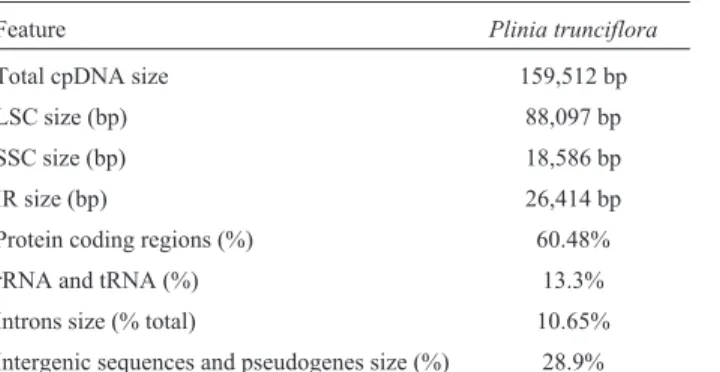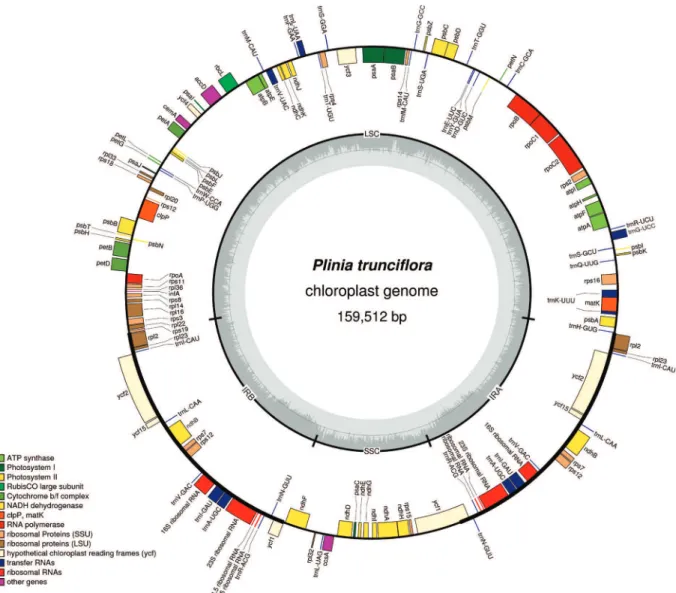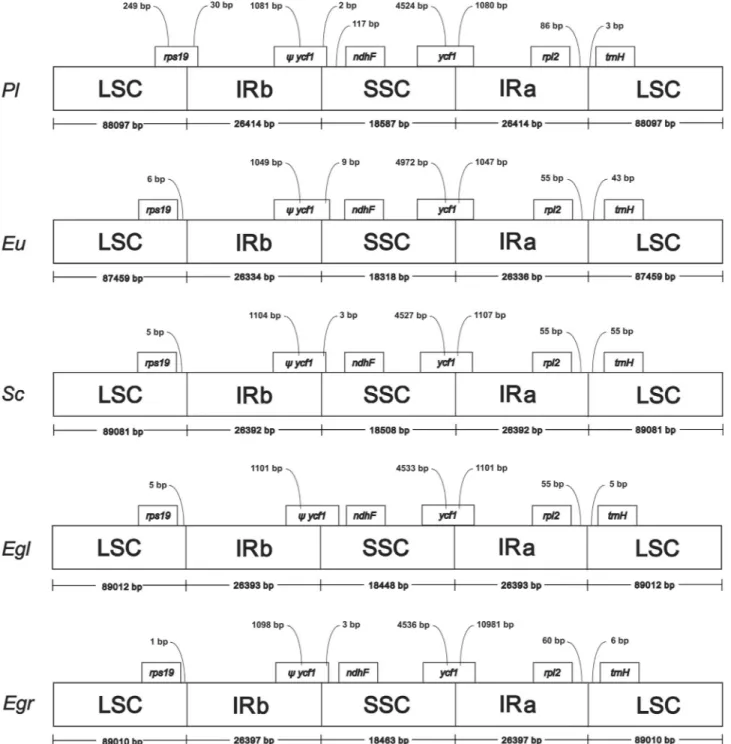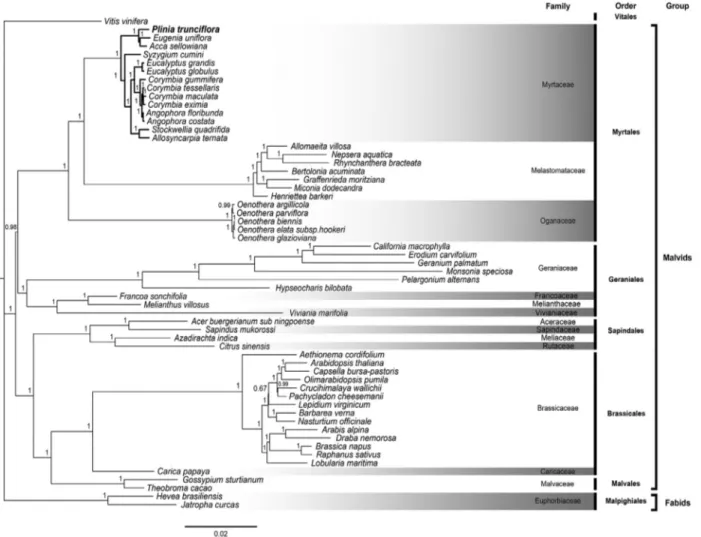Complete sequence and comparative analysis of the chloroplast genome of
Plinia trunciflora
Maria Eguiluz
1, Priscila Mary Yuyama
2, Frank Guzman
2, Nureyev Ferreira Rodrigues
1and Rogerio
Margis
1,21
Programa de Pós-Graduação em Genética e Biologia Molecular, Universidade Federal do Rio Grande do
Sul (UFRGS), Porto Alegre, RS, Brazil.
2
Departamento de Biofísica, Centro de Biotecnologia, Laboratório de Genomas e Populações de Plantas,
Universidade Federal do Rio Grande do Sul (UFRGS), Porto Alegre, RS, Brazil.
Abstract
Plinia trunciflora is a Brazilian native fruit tree from the Myrtaceae family, also known as jaboticaba. This species has great potential by its fruit production. Due to the high content of essential oils in their leaves and of anthocyanins in the fruits, there is also an increasing interest by the pharmaceutical industry. Nevertheless, there are few studies fo-cusing on its molecular biology and genetic characterization. We herein report the complete chloroplast (cp) genome
of P. trunciflora using high-throughput sequencing and compare it to other previously sequenced Myrtaceae
genomes. The cp genome ofP. trunciflora is 159,512 bp in size, comprising inverted repeats of 26,414 bp and sin-gle-copy regions of 88,097 bp (LSC) and 18,587 bp (SSC). The genome contains 111 sinsin-gle-copy genes (77 pro-tein-coding, 30 tRNA and four rRNA genes). Phylogenetic analysis using 57 cp protein-coding genes demonstrated thatP. trunciflora, Eugenia uniflora and Acca sellowiana form a cluster with closer relationship to Syzygium cumini than withEucalyptus. The complete cp sequence reported here can be used in evolutionary and population genetics studies, contributing to resolve the complex taxonomy of this species and fill the gap in genetic characterization.
Keywords: Jaboticaba, Myrtaceae, chloroplast genome, next-generation sequencing.
Received: April 18, 2017; Accepted: July 13, 2017.
Plinia trunciflora (O.Berg) Kausel, synonym Myrciaria truncifloraO.Berg, is a native Brazilian tree that belongs to the Myrtaceae family and is widely distributed in the southern and southeastern areas of Brazil (Sobralet al., 2012). Among all identified Plinia sp. species, P. cauliflora (DC.) Berg (synonym M. cauliflora (Mart.) O.Berg),P. jaboticaba(Vell.) Berg (synonymM. jabotica-baO.Berg) andP. truncifloraare endemic to Brazil. All of these species produce a similar grape-like edible fruit, known as jaboticaba, which presents a sweet jelly-like white pulp covered by a purple peel. Jaboticaba (P. trunciflora) has attracted attention because of its significant levels of phenolic compounds associated with health bene-fits, such as antidepressant and antioxidant effects and the prevention of neurodegenerative diseases and diabetes (Stasi and Hiruma-Lima, 2002; Sacchetet al., 2015). These benefits have largely been attributed to the capacity of these compounds to prevent or reduce oxidative stress.
Addi-tionally, jaboticaba (P. trunciflora) is largely consumed fresh or used to make jellies, juices, wines, spirits and vine-gar (Balerdiet al., 2006).
Despite the nutritional and productive recognized im-portance of this species, the taxonomic classification is still controversial. This is mostly so because it is based on mor-phological evaluation of the trees, fruits and seeds, regard-ing physical, chemical, physicochemical, and germinal characters that have shown the existence of variability (Guedes et al., 2014). Therefore, molecular studies are needed to better clarify the phylogenetic relationships among the species from this genus.
The chloroplast (cp) genome is a circular molecule of double-stranded DNA that consists of four distinct regions, a large and a small single copy region (LSC and SSC, re-spectively) separated by two inverted repeat regions (IRa and IRb). Despite the high degree of conservation in its structure, gene content and organization, the presence of mutations, duplications and rearrangements of genes make it an attractive option for phylogenetic studies (Costaet al., 2016). In the case of Myrtaceae, there are only few phylo-genetic and evolutionary studies based on cp genes (Craven and Biffin 2005; Paynet al., 2007; Biffinet al., 2010; Bayly
Send correspondence to Rogerio Margis. Departamento de Bio-física, Centro de Biotecnologia, Laboratório de Genomas e Popu-lações de Plantas, Universidade Federal do Rio Grande do Sul (UFRGS), Avenida Bento Gonçalves 9500, Prédio 43432, Sala 206, Porto Alegre, RS, CEP 91501-970 Brazil. E-mail: rogerio.margis@ufrgs.br.
et al., 2013; Eguiluzet al., 2017; Machadoet al., 2017), and there are even less that include thePliniagenus (Vascon-celoset al., 2017).
In this study, young leaves from aPlinia trunciflora tree harvested in Gravataí, RS, Brazil (latitude (S): 29°51’52"; longitude (W): 50°53’53") were used to extract total DNA by the CTAB method (Doyle and Doyle, 1990). DNA quality was evaluated by electrophoresis in a 1% agarose gel, and DNA quantity was determined using a NanoDrop spectrophotometer (NanoDrop Technologies, Wilmington, DE, USA). One genomic paired-end library of 100 nt length was generated by Fasteris SA (Plan-les-Ouates, Switzerland) using an Illumina HiSeq2000 plat-form (Illumina Inc., San Diego, CA, USA). The paired-end sequence reads were filtered against 42 Myrtaceae cp geno-mes (Table S1) using BWA software with two mismatches allowed (Li and Durbin, 2009). The obtained reads were as-sembledde novo with ABySS software (Simpson et al., 2009). The cp genome scaffolds were orientated using cp genome sequences of Eucalyptus globulus, Eucalyptus grandisandEugenia unifloraL. using BLASTN (Camacho et al., 2009). A gap region was filled in by Sanger sequenc-ing ussequenc-ing primers F: 5’ GGGTTATCCTGCACTTGGAA and R: 3’ TGCTGTCGAAGCTCCATCTA. Genes were annotated using DOGMA (Wyman et al., 2004) and BLAST homology searches. tRNAs (transfer RNA) were predicted using tRNAscan-SE program (Schattner et al., 2005) and confirmed by comparison with the appropriate homologs inE. globulus. The circular cp genome map was drawn using OGDRAW online program (Lohse et al., 2007). For the phylogenetic analysis, a set of 57 cp pro-tein-coding sequences (Table S2) from 56 species belong-ing to Malvids (Eurosids II) (Table S3) were used withVitis viniferaserving as outgroup. Nucleotide sequences were aligned using MUSCLE available in MEGA version 6.0 (Tamuraet al., 2013), and a Bayesian tree was generated using MrBayes version 3.1.2 (Ronquist and Huelsenbeck, 2003) with 5,000,000 generations sampled every 100 gen-erations and discarding the first 25% of trees as burn-in, with posterior probability (PP) values for each node. The GTR+I+G nucleotide substitution model determined by
MODELTEST version 3.7 (Posada and Crandall, 1998) was used. The phylogenetic tree was rooted and visualized using FigTree software (http://tree.bio.ed.ac.uk/soft-ware/figtree/).
A total of 148,824,244 raw Illumina paired-end reads from the P. truncliflora nuclear genome were filtered against 42 Myrtaceae cp genomes. The 8,912,157 obtained reads werede novoassembled into non-redundant contigs and singletons covering about 99% of the genome (mini-mum coverage=144 reads, maxi(mini-mum coverage=18,789 reads). Two final large scaffolds were obtained and joined into a cp circular genome using Sanger sequencing. The complete cp genome ofP. trunciflorais 159,512 bp in size and was submitted to GenBank (accession number: KU318111). The size is similar to that of other Myrtaceae species (Eguiluzet al., 2017; Machadoet al., 2017). The cp genome included an LSC region of 88,097 bp, an SSC re-gion of 18,587 bp and a pair of inverted repeats (IRa and IRb) of 26,414 bp each (Figure 1). Coding regions com-prise 47.2%, 13.3% correspond to rRNAs and tRNAs, and 39.5% of the genome comprises non-coding regions, in-cluding introns, pseudogenes and intergenic spacers (Table 1). In general, all genomic features showed similarity in structure and gene abundance with other Myrtaceae species (Baylyet al., 2013; Eguiluzet al., 2017; Machadoet al., 2017). The genome contained 131 genes in total, which in-cludes 111 single-copy genes corresponding to 77 pro-tein-coding genes, 30 transfer RNA (tRNA) genes and four ribosomal genes (rRNA) (Figure 1, Table 1). Theycf1,ycf2 andycf15sequences were annotated as pseudogenes based on the presence of many stop codons in their coding se-quences and by comparison with sese-quences ofE. globulus andS. cumini. Of the 131 genes inP. trunciflora, seven of the tRNAs genes and all four rRNA genes occurred within the IR regions and consequently were duplicated (Table 1). The cp genome has 20 intron-containing genes: 12 protein coding genes and six tRNA genes which contain one intron, and theclpPandycf3genes that contain two introns each. Therps12gene is a trans-spliced gene with the 5’end lo-cated in the LSC region and the duplilo-cated 3’end in the IR
872 Eguiluzet al.
Table 1- Summary of thePlinia trunciflorachloroplast genome characteristics.
Feature Plinia trunciflora
Total cpDNA size 159,512 bp
LSC size (bp) 88,097 bp
SSC size (bp) 18,586 bp
IR size (bp) 26,414 bp
Protein coding regions (%) 60.48%
rRNA and tRNA (%) 13.3%
Introns size (% total) 10.65%
Intergenic sequences and pseudogenes size (%) 28.9%
Feature Plinia trunciflora
Number of genes 131 genes
Number of different protein coding genes 77
Number of different tRNA genes 30
Number of different rRNA genes 4
Number of different duplicated genes 16
Pseudogenes 3
regions. The trnK-UUU has 2,529 bp, with the largest intron encompassing also thematKgene.
The whole cp genome analysis revealed that the cp genomes ofP. trunciflora andE. uniflora are shorter in comparison to other Myrtaceae, such as E. globulus, E. grandis, E. unifloraandS. cumini, (Figure 2). Despite its size, the total length of introns inP. trunciflora(16,972 pb) is the largest in Myrtaceae, e.g.S. cuminipresents 14,469 bp and the same is observed inE. globulusandE. grandis. The size of the intergenic spacer located between the IRa/LSC border and the first gene of LSC inP. trunciflora is more similar toEucalyptusspecies than its closer species E. uniflora(Figure 2). The comparison of thendhKgene of P. trunciflora, with 678 bp, indicated a smaller gene size than that in other plants, such asE. uniflora (858 pb),S. cumini(855 bp),E. globulus(855 bp) andE. grandis(853 bp). The same size (678 bp) for this gene is found in
Arabidopsis thaliana. The effective size of the coding sequence is confirmed by the presence of a thymine in posi-tion 53,811 bp in the cp genome fromP. trunciflorathat creates a stop codon and makes this gene shorter than in other Myrtaceae.
Our phylogeny includes the sister relationship of the orders Brassicales, Malvales and Sapindales and the orders Geraniales and Myrtales. All these results agree with previ-ous studies based on multiple genes or complete cp geno-mes (Ruhfel et al., 2014). By analyzing the Myrtaceae family clade we showed thatP. trunciflora,E. unifloraand Acca sellowiana form a single cluster of Neotropical Myrtaceae, and that this clade has a shorter genetic distance withS. cuminithan to the Australian Myrtaceae clade (Fig-ure 3). Additionally, our analysis corroborates that Corymbia gummiferais paraphyletic in respect to Ango-phora. A previous phylogenetic analysis using certain cp
genes (ITS,matKandndhF) of Myrtaceae species showed that Eucalyptus, Syzygium,Eugenia andMyrciaria (syn-onym ofPlinia) form a distinct clade that is consistent with characteristics of the pollen (Thornhillet al., 2012). As can be observed in the Bayesian tree (Figure 3),Pliniacould be paraphyletic in relation toEugeniaandAcca, in agreement with the embryo morphology and studies using cp regions that placed Plinia, Myrciaria and Siphoneugena as the
emerging “Plinia group” (Lucas et al., 2007). Taxon sampling and phylogenetic methodology could affect the different results. Therefore, additional complete cp genome sequences will help in the comprehension of the relation-ship among Myrtaceae species.
The Plinia trunciflora genome represents the first complete cp genome sequence for the genus Plinia and shows a set of features that could be further explored for
874 Eguiluzet al.
Figure 2- Comparison of the borders of LSC, SSC and IR regions among five chloroplast genomes. Boxes above the main line indicate the predicted genes, while pseudogenes at the borders are shown byY. Variation inrps19gene length is displayed at the IRb/LSC borders ofPlinia trunciflora,
population and phylogenetic studies within this group. Moreover, these data increase the genetic and genomic re-sources available in Myrtaceae by adding a new strategy of organelle genome assembly.
Acknowledgments
This study was carried out with financial support from the Conselho Nacional de Desenvolvimento Cientí-fico e Tecnológico (CNPq), Coordenação de Aperfeiçoa-mento de Pessoal de Nível Superior (CAPES) and Fundação de Amparo à Pesquisa do Rio Grande do Sul (FAPERGS).
References
Bayly MJ, Rigault P, Spokevicius A, Ladiges PY, Ades PK, An-derson C, Bossinger G, Merchant A, Udovicic F, Woodrow IE,et al.(2013) Chloroplast genome analysis of Australian eucalypts - Eucalyptus, Corymbia, Angophora,
Allosyn-carpia and Stockwellia (Myrtaceae). Mol Phylogenet Evol 69:704-716.
Balerdi CF, Rafie R and Crane J (2006) Jaboticaba (Myrciaria cauliflora, Berg.) a delicious fruit with an excellent market potential. Proc Florida State Hortic Soc 119:66-68. Biffin E, Lucas EJ, Craven L, Da Costa IR, Harrington MG and
Crisp MD (2010) Evolution of exceptional species richness among lineages of fleshy-fruited Myrtaceae. Ann Bot 106:79-93.
Camacho C, Coulouris G, Avagyan V, Ma N, Papadopoulos J, Bealer K and Madden TL (2009) BLAST+: Architecture and applications. BMC Bioinformatics 10:421.
Costa JF, Lin SM, Macaya EC, Fernández-García C and Verbrug-genet H (2016) Chloroplast genomes as a tool to resolve red algal phylogenies: A case study in the Nemaliales. BMC Evol Biol 16:205.
Craven LA and Biffin E (2005)Anetholea anisatatransferred to, and two new Australian taxa of Syzygium (Myrtaceae). Blumea 50:157-162.
Doyle JJ and Doyle JL (1990) Isolation of plant DNA from fresh tissue. Focus 12:13-15.
Eguiluz M, Rodrigues FN, Guzman F, Yuyama P and Margis R (2017) The chloroplast genome sequence from Eugenia uniflora, a Myrtaceae from Neotropics. Plant Syst Evol doi: 10.1007/s00606-017-1431-x.
Guedes MNS, Rufini JCM, Azevedo AM and Pinto NAVD (2014) Fruit quality of jabuticaba progenies cultivated in a tropical climate of altitude. Fruits 69:449-458.
Li H and Durbin R (2009) Fast and accurate short read alignment with Burrows-Wheeler transform. Bioinformatics 25:1754-1760.
Lohse M, Drechsel O and Bock R (2007) Organellar Genome DRAW (OGDRAW): A tool for the easy generation of high-quality custom graphical maps of plastid and mito-chondrial genomes. Curr Genet 52:267-274.
Lucas EJ, Harris SA, Mazine FF, Belsham SR, Lughadha EMN, Telford A, Gasson PE and Chase MW (2007) Suprageneric phylogenetics of Myrteae, the generically richest tribe in Myrtaceae (Myrtales). Taxon 56:1105-1128.
Machado LO, Vieira LD, Stefenon VM, Pedrosa OF, De Souza EM, Guerra MP and Nodari RO (2017) Phylogenomic rela-tionship of feijoa (Acca sellowiana(O.Berg) Burret) with other Myrtaceae based on complete chloroplast genome se-quences. Genetica 145:1-12.
Payn KG, Dvorak WS and Myburg AA (2007) Chloroplast DNA phylogeography reveals the island colonisation route of Eu-calyptus urophylla(Myrtaceae). Aust J Bot 55:673-683. Posada D and Crandall KA (1998) MODELTEST: Testing the
model of DNA substitution. Bioinformatics 14:817-818. Ronquist F and Huelsenbeck JP (2003) MRBAYES 3: Bayesian
phylogenetic inference under mixed models. Bioinformatics 19:1572-1574.
Ruhfel BR, Gitzendanner MA, Soltis PS, Soltis DE and Burleigh JG (2014) From algae to angiosperms-inferring the phylog-eny of green plants (Viridiplantae) from 360 plastid geno-mes. BMC Evol Biol 14:23.
Sacchet C, Mocelin R, Sachett A, Bevilaqua F, Chitolina R, Kuhn F, Boligon AA, Athayde ML, Roman Junior WA, Rosem-berg DB,et al.(2015) Antidepressant-like and antioxidant effects ofPlinia trunciflorain mice. Evid Based Comple-ment Alternat Med 2015:601503.
Stasi LC and Hiruma-Lima CA (2002) Myrtales medicinais. In: Stasi LC and Hiruma-Lima CA (eds) Plantas Medicinais na Amazônia e na Mata Atlântica.2nd edition. Editora UNESP, São Paulo, pp 321-330.
Schattner P, Brooks AN and Lowe TM (2005) The tRNAscan-SE, snoscan and snoGPS web servers for the detection of tRNAs and snoRNAs. Nucleic Acids Res 33:W686-W689. Simpson JT, Wong K, Jackman SD, Schein JE, Jones SJM and
Birol I (2009) ABySS: A parallel assembler for short read sequence data. Genome Res 19:1117-1123.
Tamura K, Stecher G, Peterson D, Filipski A and Kumar S (2013) MEGA6: Molecular Evolutionary Genetics Analysis ver-sion 6.0. Mol Biol Evol 30:2725-2729.
Thornhill AH, Hope GS, Craven LA and Crisp MD (2012) Pollen morphology of the Myrtaceae. Part 4: Tribes Kanieae, Myrteae and Tristanieae. Aust J Bot 60:260-289.
Wyman SK, Jansen RK and Boore JL (2004) Automatic annota-tion of organellar genomes with DOGMA. Bioinformatics 20:3252-3255.
Vasconcelos NCT, Proença EBC, Ahmad B, Aguilar SD, Aguilar R, Amorim SB, Campbell K, Costa RI, De-Carvalho SP, Faria EQJ, et al. (2017) Myrteae phylogeny, calibration, biogeography and diversification patterns: Increased under-standing in the most species rich tribe of Myrtaceae. Mol Phylogenet Evol 109:113-137.
Internet Resources
Sobral M, Proença C, Souza M, Mazine F and Lucas E (2012) Myrtaceae in lista de espécies da flora do Brasil. Jardim
Botânico do Rio de Janeiro [online],
http://floradobrasil.jbrj.gov.br (accessed 16 September 2015).
Supplementary material
The following online material is available for this article: Table S1 - List of 42 Myrtaceae chloroplast genomes used in
chloroplast genome assembling ofPlinia trunciflora. Table S2 - List of 57 chloroplast protein coding genes used in the
phylogenetic analysis.
Table S3 - List of 56 plastome sequences of Rosids included in the Bayesian phylogenetic analysis.
Associate Editor: Guilherme Corrêa de Oliveira
License information: This is an open-access article distributed under the terms of the Creative Commons Attribution License (type CC-BY), which permits unrestricted use, distribution and reproduction in any medium, provided the original article is properly cited.



